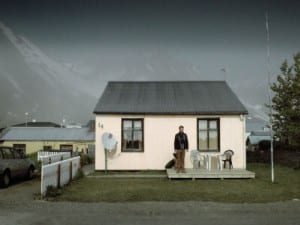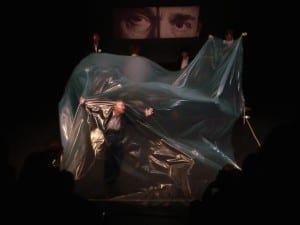Review by Karla Evans
Mounting an exhibition that addresses 75 years worth of work and features over 50 photographers is no meagre task. Compliments then are due to the team behind the Royal Academy of Art’s Eyewitness: Hungarian Photography in the 20th Century. Taking visitors from 1914 through 1989, the Academy’s first photography exhibition in many, many years will quash any doubts of a staid historical show and presents some of the most provocative images of the century. What seems nigh on impossible to do without filling the Royal Academy’s entire floor-space, the curators manage to do in a coherent and succinct exhibition of two distinct parts. Firstly, presenting a clear, chronological retelling of Hungary’s conflicted history and secondly, how Hungarian photographers translated the century’s technological advances within the medium of photography through their own unique lens’.
It does of course help that five of the world’s greatest photographers are Hungarian and it is these familiar names —Brassaï, Capa, Kertész, Moholy-Nagy and Munkácsi— who act as the foundation for the show. Appearing at intervals through the exhibition, the five garner many a second look with their instantly recognisable images that range from Brassaï’s celebrity-filled portraits to Capa’s iconic war photography. It is no coincidence that all five fled their home country as Hungary drew closer to communism and it is in Paris, New York and beyond, we see their work evolve.
Andre Kertész, Lászlo Moholy-Nagy and Martin Munkácsi’s are plucked out for their innovative experiments of a medium going through its most dramatic period of change. We see Moholy-Nagy’s dalliance in light sensitive paper, producing delicate photograms and perfectly pitched solarisations. Moholy-Nagy’s Two Nudes, Positive and Two Nudes, Negative beautifully shows his revolutionary creation in which the same image is repeated exactly except for the inversion of colours. The much-referenced Kertész, however, steers away from the technology and flits instead between great stylistic differences, with a body of work alternating from vast Hungarian plains to artful still life compositions not dissimilar to Irving Penn. Kertész appears as a ruthless editor to his images; cropping his photographs to create the best frame or taking pictures from unusual angles to capture the precise moment; a visionary in the medium.
Arguably, it will be Munkácsi who appeals most fondly to magazine-friendly eyes. After his success in using 35mm film to capture motion in sports reportage Munkácsi used the same technique for fashion stories. Being employed by Harper’s Bazaar Munkácsi created whimsical beach shoots of frolicking girls wearing billowing capes that wouldn’t seem out of place in today’s style pages. It is clear to see why Munkácsi is still referred to as one of the founding fathers of fashion photography and has an undeniable association with Bruce Weber and Richard Avedon.
The highlight of the exhibition comes from Brassaï, who gained infamy with his romantic and dreamy scenes of Paris that continue to act as tourists’ inspiration to make pilgrimages to the City of Lights. Brassaï’s 1933 Parisian images (collected in the book, also on show, Paris de Nuit) depict the city as an alluring metropolis of midnight walks along the Seine and bewitching meetings with strangers in underground bars: a beguiling culture seems to open up before your eyes. Brassaï’s artist portraits of Picasso, Matisse and Chagall on show all add to his magnetic aura.
Where Brassaï brings the glamour, Capa brings an unflinching reality. A fearless and dedicated war photographer Capa rarely shied away from conflict with a collection of images taken from the ground in the 1936 Spanish Civil War including the unforgettable Death of a Loyalist Militiaman that appears to document a bullet passing fatally through a soldier. Capa even braved D-Day and joined the US soldiers landing on Omaha Beach, Normandy producing a series of powerful in-action prints that encapsulate his resolute style of photography.
It is worth remembering these five key photographers stand amongst a mix of amateur and professional artists who offer their own insight into Hungary’s defining period of extreme metamorphosis, pre and post communism. They include moments of great beauty from Kata Kálmán’s gritty portraits of weather beaten workers in 1932 and moments of visionary architectural photography and compositional masterminding from Angelo.
This is not a show to view briefly with a mere half-hour to spare but demands time and mind space to soak up the history, and allow a real understanding of the work and great photographers this country produced in the 20th century. The power of the exhibition and its subsequent success begs to ask the question, why the Royal Academy doesn’t consider the medium of photography more often?
Eyewitness: Hungarian Photography in the 20th Century is on show at Royal Academy of Art, Sackler Wing of Galleries until 2 October.
royalacademy.org.uk
Aesthetica Magazine
We hope you enjoying reading the Aesthetica Blog, if you want to explore more of the best in contemporary arts and culture you should read us in print too. In the spirit of celebration, Issue 41 includes a piece on Guggenheimn Bilbao where the Luminous Interval features internationally acclaimed artists such as Louise Bourgeois, Kiki Smith and Damien Hirst, ArtAngel’s new commission at MIF, Bruce Nauman’s retrospective at The Kunsthalle Mannheim and Cory Arcangel’s Pro Tools at the Whitney in NYC. You can buy it today by calling +44(0)1904 479 168. Even better, subscribe to Aesthetica and save 20%. Go on, enjoy!
Image:
László Fejes
Wedding, Budapest (1965)
Courtesy Hungarian Museum of Photography





